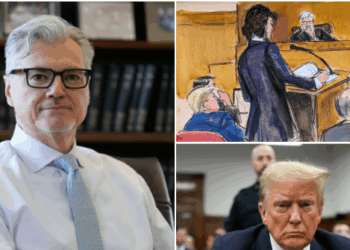President Donald Trump announced on Monday that he would take control of the police force in Washington, D.C. and deploy 800 National Guard troops to quell crime and remove homeless encampments in the city.
Flanked by Defense Secretary Pete Hegseth and Attorney General Pam Bondi, Trump said he was deploying troops to “help reestablish law, order and public safety” in the nation’s capital, which he claimed had been “overtaken by violent gangs and bloodthirsty criminals.” It comes just months after federal officials announced that violent crime in the city hit a 30-year low.
The move is the latest in a string of military deployments on home soil by Trump that experts say represents a marked departure from his predecessors.
It comes just two months after Trump deployed California’s National Guard to quell protests in Los Angeles over his immigration policies, after the protests had largely died down.
Read more: ‘This Will Go Further’: Trump Puts D.C. Police Under His Control and Deploys National Guard
William Banks, professor of law at Syracuse University and an expert on the role of the military in domestic affairs, says Trump’s move is likely intended as a “symbolic” show of power, especially after a former DOGE staffer’s assault in the city caught his attention.
“Symbolism has always been very important to Trump,” Banks tells TIME. “Trump wants to clean the city up. He wants to make it look like the White House lawn.”
Banks adds that the United States has always been “unique” in its allocation of law enforcement to civilians and its general refusal to use the military on its own citizens.
“The [British] soldiers in the colonies ransacked people’s homes, arrested people without cause, beat people up, stole their papers, [and] violated their privacy, so by the time of revolution and then the Constitution, we didn’t have a good feeling about the presence of soldiers on our streets,” Banks says. “We want our members of our community, our neighbors, people that we know and recognize, in civilian uniform.”
Banks acknowledges that the Constitution recognizes there may be “exceptional circumstances” where a military presence is required domestically, but that Presidents prior to Trump did so more sparingly. He points to what he calls “rights-promoting deployments” of the National Guard, including by Lyndon B. Johnson to desegregate schools in Alabama and Mississippi.
Though Trump focused on D.C., he also hinted that the capital city is just the beginning, mentioning New York City, Baltimore, and Oakland—cities in which he has much less jurisdiction.
“This will go further,” Trump said. “We are starting strongly with D.C.”
Here is where Trump has chosen to deploy federal troops during his two terms.
Along the border
During Trump’s first term, he deployed the National Guard to the U.S.-Mexico border in a bid to cut down on illegal immigration. Trump’s first term, much like his second, was defined by his aggressive immigration tactics.
At the time, Trump’s proclamation justified his deployment of troops by pointing to a surge of apprehensions at the border, while critics said that overall border crossings were at historic lows.
This deployment of the National Guard at the border continued during his second term. In May of this year, thousands of National Guard troops were deployed to the Southern Border, escalating his crackdown on immigration. “National Defense Areas” were established in New Mexico and Texas.
Importantly, federal troops have been deployed at the border during previous Administrations, specifically to aid Border Patrol. Trump’s expansion of military zones along the U.S. border, though, has empowered the military to further act as a law enforcement body, detaining and searching those who they consider as trespassing in these defense areas.
Typically, the President would need Congressional approval for defense areas and the creation of essentially a 170-mile military installation, but the President’s Day One declaration of a national emergency on the southern border in an Executive Order allowed him to sidestep this formalization.
Black Lives Matter protests, 2020
In May 2020, protests broke out across the country in response to the murder of George Floyd by a police officer. The protests marked one of the largest protest movements in U.S. history, with estimates of as many as 26 million people participating in the call for racial justice.
Tens of thousands of National Guard troops in over half of U.S. states were activated by state governors to deal with the Black Lives Matter protests, but Trump also used his own powers to deal with the unrest.
In August 2020, Trump deployed federal forces to Kenosha, Wisconsin, to quell protests in the aftermath of the shooting of Jacob Blake by a police officer.
The Department of Homeland Security (DHS) also sent hundreds of federal officers to Portland, Oregon, to handle protests, with some reports, including one from the ACLU, claiming that these federal agents grabbed protestors off the streets in unmarked vehicles. Tactical teams of the Customs and Border Patrol (CBP) were also sent to Seattle, Washington, though push back by former Washington Gov. Jay Inslee and former Mayor Jenny Durkan eventually led to their withdrawal.
In D.C., though, Trump, acting as Commander-in-Chief, deployed National Guard members from several states, despite public criticism from D.C. Mayor Muriel Bowser.
Trump’s National Guard in D.C. also notoriously utilized tear-gas and rubber bullets against these Black Lives Matter protestors to disperse the demonstration and make room for a photo-op at St. John’s Episcopal Church, which had been vandalized the night before during protests with a fire in the basement.
Eventually, Trump threatened to utilize the Insurrection Act to deploy military forces to suppress the protests, calling the protestors “terrorists.” Here, though, the Pentagon publicly broke from Trump, as Defense Secretary Mark Esper said he would prefer to not use active duty military on protests analyzed to have been mostly peaceful.
Banks notes that Trump, as Commander-in-Chief of D.C., has more authority here than in the states, but adds “one of the ironies is that in one of the few instances where there really was a violent disturbance inside the district—January 6, [2021]—[Trump] did nothing.” He continued, stating that if Trump had deployed the National Guard during the Jan. 6 insurrection, “they could have stopped the Capitol rioting in 30 minutes.”
Los Angeles, June 2025
President Trump deployed the California National Guard and the Marines in June this year, ostensibly to quell protests in Los Angeles against Trump’s aggressive immigration policies and the intense escalation of deportations in the interior by Immigration and Customs Enforcement (ICE) agents.
Trump’s deployment of the National Guard came with a Presidential Memorandum that invoked Title 10, Section 12406 of the U.S. Code, which allows for the federal deployment of National Guard forces in limited circumstances, including if “there is a rebellion or danger of a rebellion against the authority of the Government of the United States.”
When deployed, though, the National Guard was tasked with protecting ICE agents and federal property, and they were not authorized to perform any law enforcement activities. Trump was criticized for the move, with California Gov. Gavin Newsom calling the deployment “purposefully inflammatory” and the American Civil Liberties Union (ACLU) Southern California describing it as “akin to a declaration of war on all Californians.”
Currently, only 300 of the 5,000 troops deployed remain in Los Angeles, as a trial begins over the legality of Trump’s deployment in the first place. A California federal judge is to rule whether Trump’s use of the troops violates the Posse Comitatus Act, which limits the use of the military in domestic law enforcement.
The post Trump Has Deployed Troops At Home Like No Other President. Here is Where He Has Sent Them appeared first on TIME.




